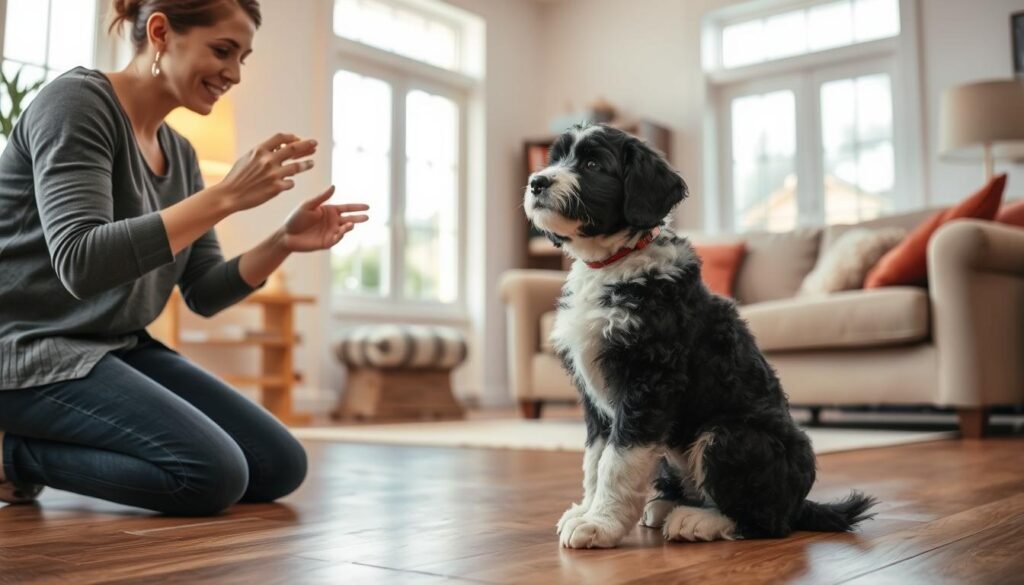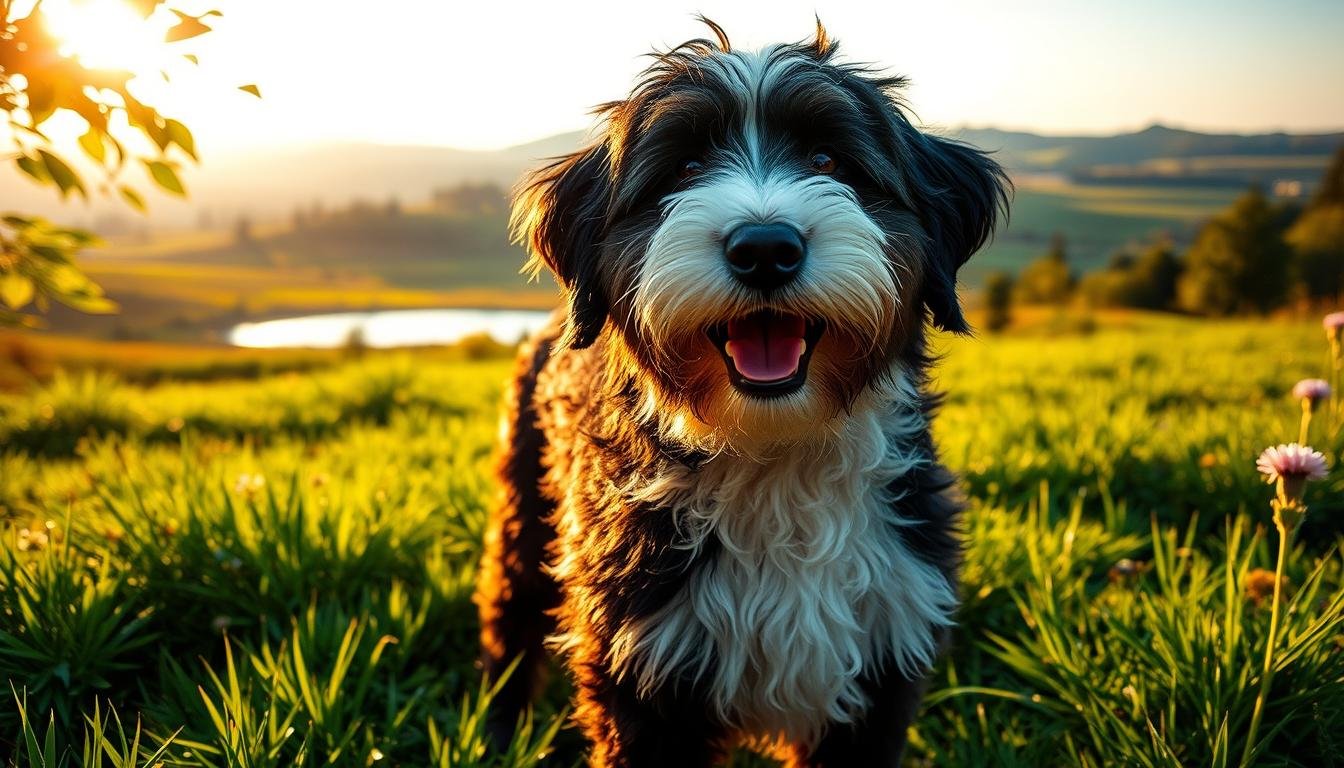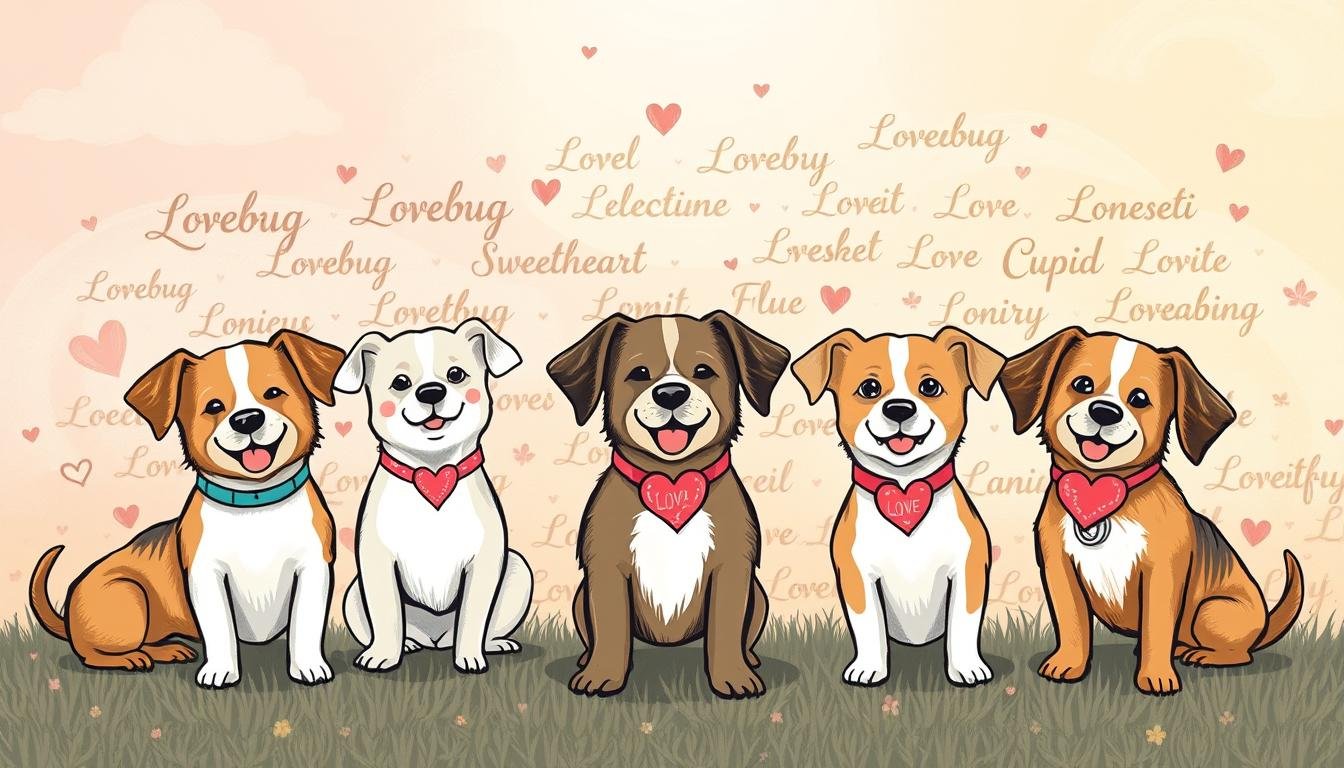Picture this: a loyal friend who greets you with wagging enthusiasm, snuggles like a living teddy bear, and doesn’t leave a fur coat on your sofa. If that sounds like a dream come true, you’re not alone. Many families crave a four-legged companion that blends brains, beauty, and a sneeze-free lifestyle—and that’s exactly where this clever hybrid shines.
Born from the creative vision of a Canadian breeder in 2003, this crossbreed merges the Poodle’s sharp wit and hypoallergenic coat with the calm devotion of its larger parent. The result? A low-shedding, allergy-friendly charmer that’s equal parts playful goofball and gentle guardian. Whether they’re mastering new tricks or melting hearts at the pediatrician’s office (yes, they’re fantastic therapy dogs), these pups redefine what it means to be man’s best friend.
We’ve watched this breed rise from niche novelty to America’s favorite fuzzy confidant, and we’re here to share why they’re more than just a pretty face. From their surprisingly tidy coats to their uncanny ability to sense when you need extra love, let’s explore what makes this hybrid the ultimate modern companion.
Key Takeaways
- Hypoallergenic coats make this hybrid ideal for allergy sufferers
- Combines a Poodle’s intelligence with a calm, affectionate nature
- First intentionally bred in 2003 to address health concerns
- Thrives as both family pets and therapy animals
- Gained rapid popularity for its adaptable personality
Introduction & Unique Appeal
Imagine a dog that’s both a brainiac and a cuddle expert—no, we’re not describing a Disney character. This hybrid’s origin story reads like a canine fairy tale, blending Swiss work ethic with German ingenuity. Canadian breeder Sherry Rupke sparked a revolution in 2003 by merging two iconic breeds, creating what many now call the ultimate family companion.
A Brief History and Background
Rupke’s genius move addressed two critical needs: allergy-friendly coats and improved longevity. The Swiss Alps’ sturdy draft animals met Germany’s sharp-witted water retrievers, resulting in a pup that thinks like a professor and loves like a nanny. We’re talking about a lineage where farmyard brawn dances with aristocratic brains.
Families today adore this mix because it solves modern problems. Kids get a patient playmate that doesn’t shed like a blizzard, while adults appreciate the Einstein-level trainability. It’s no wonder these curly-coated charmers became the poster pups for urban households and country estates alike.
What truly sets this cross apart? It’s the rare blend of timeless traits meeting contemporary needs. You’re not just getting a pet—you’re adopting a legacy of Swiss resilience and German cleverness, wrapped in a hypoallergenic package.
Understanding the bernese mountain dog mixed with poodle

Every hybrid tells a story written in DNA. These curly-tailed charmers aren’t photocopies – they’re handcrafted genetic symphonies where Swiss stoicism meets Parisian flair. We’ve seen puppies from the same litter become polar opposites: one a contemplative philosopher, the other a class clown with a PhD in mischief.
Genetic Alchemy at Work
The magic happens when Alpine work ethic collides with circus-smart showmanship. One parent brings the steady heartbeat of mountain valleys – think warm hugs and quiet devotion. The other contributes razor-sharp wit wrapped in hypoallergenic curls. It’s like getting Shakespeare’s sonnets crossed with Einstein’s notebooks, learn more about their origins.
Personality Palette and Teddy Bear Looks
Their appearance? Nature’s Rorschach test. We’ve cataloged coats that shift from storm-cloud black to toasted marshmallow cream – sometimes all on the same dog! The real showstopper? Those soulful eyes that seem to understand your grocery list before you write it.
| Trait | Alpine Influence | Urban Twist |
|---|---|---|
| Coat Texture | Weather-resistant | Hypoallergenic waves |
| Brainpower | Practical smarts | Quick-study brilliance |
| Social Skills | Gentle protector | Party-starting charmer |
Size matters in the hybrid world. Compact versions fit city life like a glove, while larger models come with built-in lap-warmer technology. All versions share one feature – hearts bigger than their paws.
Health, Lifespan, and Common Issues
What if science class saved your dog’s life? Meet hybrid vigor in action. These curly-coated marvels showcase genetics at its finest, blending robust lineage with modern medical wisdom to create four-legged Methuselahs.
Joint Health Revolution
Let’s talk about the elephant in the room – those hip and elbow dysplasia concerns. While inherited from both parent breeds, smart breeding slashes risks dramatically. We’ve seen Standard versions benefit most from:
- DNA-tested parents
- Controlled growth diets
- Low-impact exercise routines
Early intervention transforms outcomes. A client’s 85-pound gentle giant diagnosed at 18 months now hikes daily thanks to glucosamine supplements and hydrotherapy.
Longevity Lottery Winners
| Size | Lifespan | Health Perk |
|---|---|---|
| Standard | 12-15 years | Reduced cancer risk |
| Mini | Up to 17 years | Stronger joints |
| Tiny | Up to 18 years | Heart health |
Compare this to their Bernese ancestors’ heartbreaking 7-year average, and you’ll understand why we call this crossbreed “the Benjamin Button of dogs”. Hybrid vigor isn’t just a buzzword – it’s extra years of stolen socks and slobbery kisses.
Breeder Blueprint Matters
Our golden rule? Test before you invest. Reputable breeders provide OFA certifications for hips and elbows, plus genetic screenings. One client avoided $8,000 in vet bills by choosing a properly vetted litter. Smart choices today mean fewer worries tomorrow – and more years of that signature head tilt we all adore.
Training and Socialization Tips

Think you’re training a dog? Think again—you’re actually negotiating with a fuzzy diplomat. These clever canines bring Swiss precision to negotiations (“I’ll sit… for three treats”) and French flair for dramatic sighs when bored. Our secret? Treat every lesson like a cocktail party – keep it lively, rewarding, and never let the cheese plate run dry.
The Art of Persuasion
Forget military drills – these pups respond best to what we call “snack-based democracy.” A client’s 8-month-old learned “roll over” in two days using turkey bits and exaggerated applause. The key? Timing rewards like a game show host – immediate and enthusiastic.
| Approach | Effectiveness | Reason |
|---|---|---|
| Treat + Praise | ⭐️⭐️⭐️⭐️⭐️ | Triggers food motivation |
| Clicker Training | ⭐️⭐️⭐️⭐️ | Clear communication |
| Harsh Corrections | ⭐️ | Damages trust |
Social Boot Camp
We tell new owners: “Your puppy’s social calendar should rival a Hollywood starlet’s.” One client took their 12-week-old to hardware store parking lots for “construction noise therapy.” By six months, the dog slept through leaf blowers like they were lullabies.
Early exposure prevents what we jokingly call “stranger danger syndrome.” Rotate these experiences weekly:
- Surface textures (grass, tile, gravel)
- Vehicle types (bikes, strollers, skateboards)
- Human shapes (hats, uniforms, umbrellas)
Remember – every positive encounter builds confidence. As trainer Mia Carter says:
“A well-socialized Bernedoodle doesn’t just tolerate life… they host it.”
Grooming and Coat Care

Let’s talk about the fluff factor. That Instagram-worthy teddy bear look comes with a secret: your vacuum cleaner won’t retire, but it might get bored. These pups hit the genetic jackpot with three coat variations – each demanding different levels of spa-day dedication.
Maintaining the Low-Shedding Coat
Wavy coats are the Goldilocks option – minimal shedding with weekly brush-outs. Curly types channel their poodle parent with tighter spirals that trap loose hair… until you miss a brushing session. Then it’s like untangling Christmas lights after a tornado.
Straight-haired rebels shed more but forgive the occasional skipped groom. As one stylist joked:
“Curly coats are high-maintenance relationships – ghost them for a week, and you’ll regret it.”
Professional Grooming and At-Home Care
Our grooming mantra? Start young and make it fun. Puppies who learn brushing = peanut butter time become adults who pose for nail trims. Pro tips:
- Rotate slicker brushes and metal combs
- Target trouble zones (armpits, behind ears)
- Schedule trims every 6-8 weeks
Yes, you’ll spend more on grooming than some people do on Netflix subscriptions. But proper care means no fur tumbleweeds rolling through your living room – just a dapper companion turning heads at the dog park.
Size Variations and Their Impact on Care
Choosing the right four-legged roommate isn’t just about color preferences – it’s a spatial calculation. These hybrids come in three distinct packages, each with unique care requirements that could make or break your couch’s survival chances.
From Pocket-Sized to Plus-Sized
Standard versions tip the scales at 70-90 pounds – think gentle giants who believe they’re still lap puppies. Their substantial build makes them ideal for active families with space to spare. Our complete size guide breaks down how their heritage influences growth patterns.
Mini counterparts (25-49 lbs) offer Goldilocks appeal – not too big, not too small. They’re the suburban sweethearts, equally happy hiking trails or snoozing through movie nights. Watch for bursts of energy that could power a small carnival ride.
Tiny versions redefine portable companionship at 10-24 pounds. These apartment-friendly dynamos prove good things come in small packages – especially when that package fits under an airplane seat.
While all sizes share low-shedding coats, grooming intensity scales with curl density. More fluff means more brushing marathons. One truth remains constant: every version thinks they’re the main character in your life story – and honestly, they’re not wrong.




